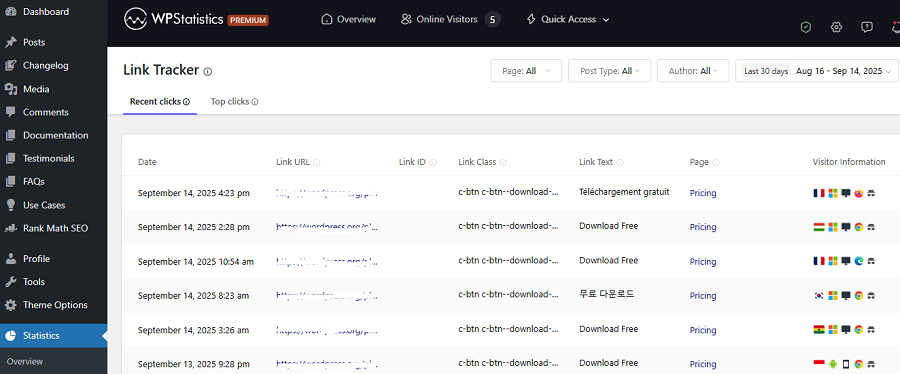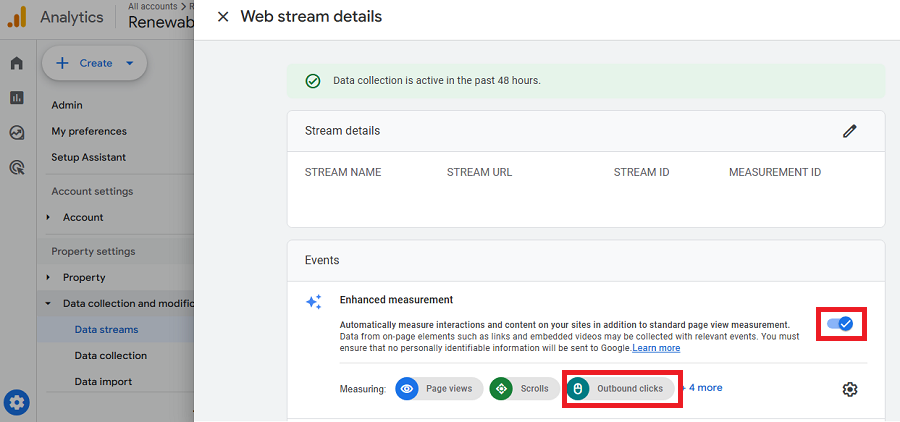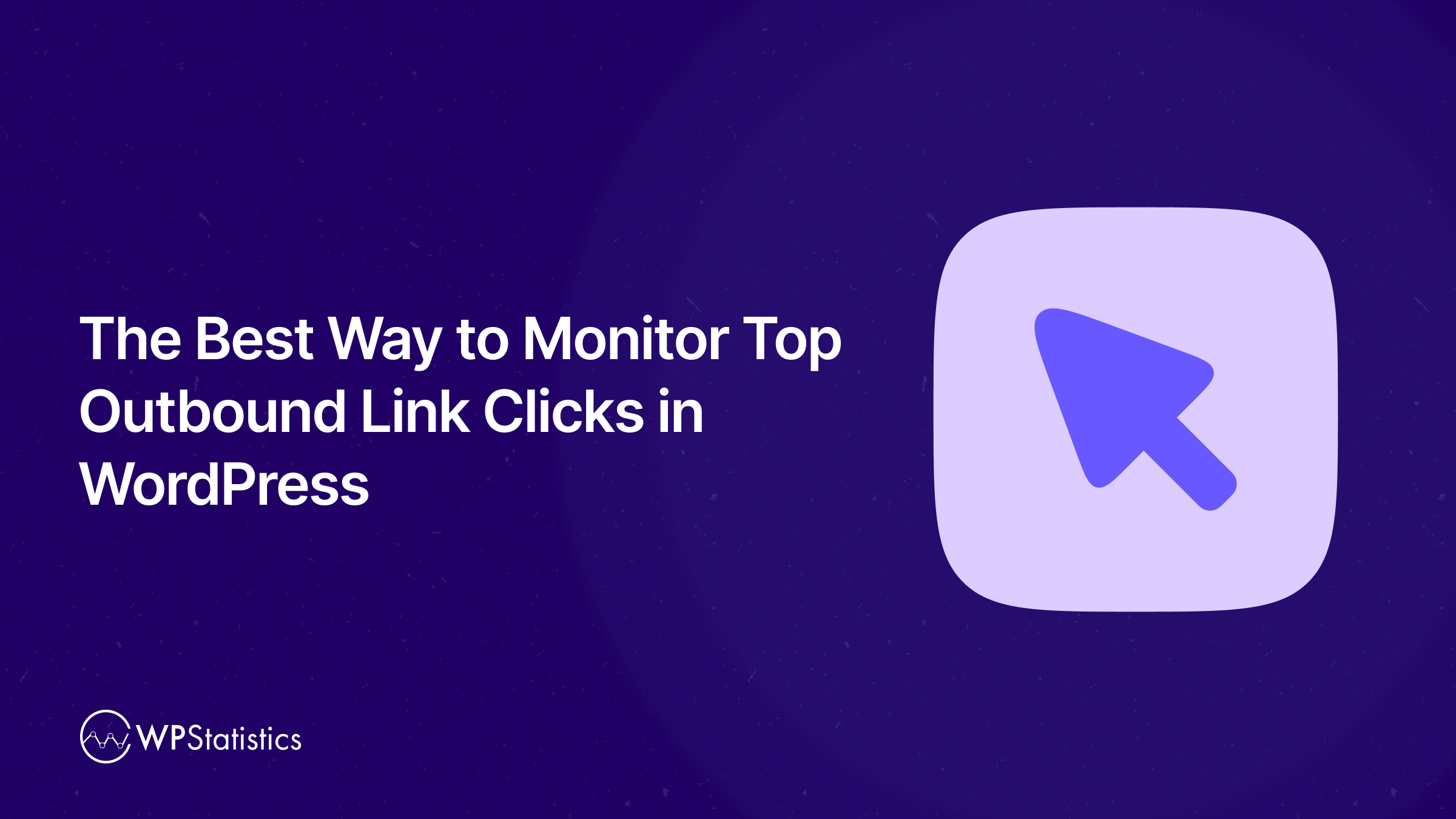Do you monitor outbound link clicks on your website?
Many website owners only focus on traffic, and this might lead to great mistakes in their SEO strategies.
To run a successful website, you have to consider many metrics and constantly optimize them. A versatile tracking approach is key to finding the strengths and weaknesses of your website and improving its performance.
One of the most underrated metrics in web analytics is outbound link clicks. It shows the behavior of your users and the way they interact with your website content.
Here, we explain why you have to take care of your external links and how to improve the CTR with outbound link monitoring.
Why Monitor Outbound Link Clicks for Your Website?
You might think that external links are just references to respect copyright. However, it’s really important in terms of SEO, user behavior, and business planning.
If you track clicks on these links, you can make smarter decisions and improve your website performance. Here are the most important benefits of tracking outbound links on your website:
1. Improving SEO and Authority
As you know, EEAt is an important signal for Google, and valid links to legitimate sources can help your site rank better.
When you track your outbound links, you can understand what type of links are trusted by your users. So, you can use links that are both attractive to users and trustworthy by Google.
2. Understanding User Behavior
Traditional analytics show the traffic source and the pages your audiences visit. However, in modern tracking, you have to see what they do after visiting your site.
For example, if they click your recommended tools instead of trying competitors’ features, your site is performing well.
These are insightful behavioral breadcrumbs that determine your audience’s intent better than many metrics, like bounce rates and page views.
3. Increasing Affiliate Marketing ROI
Outbound link tracking is essential for affiliate websites because each click on an outbound link can lead to real revenue.
By monitoring these clicks, you can:
- Identify your best products with the highest conversion rates.
- Recognize weak affiliates that are not performing well.
- Run A/B tests to find the best version of link placement, anchor text, or button design.
4. Improving Content Strategy
Tracking outbound clicks also shows what type of content your audiences like most. For example, if your readers are clicking links in your guides, tutorials, or case studies, you have to focus more on this type of content.
Also, if you see that your links in certain types of content don’t receive clicks, you have to reconsider them in your content strategy.
Remember that this is even more insightful than page traffic because it shows your audience’s interaction with your content, not just finding it in SERPs.
5. Optimizing Conversion Funnels
Outbound clicks can help you determine leaks in your funnel. For example, if you’re promoting your own product but your users are going to a competitor’s article, you have to work on your CTA.
6. Building Trust and Credibility
If you track your link clicks and improve them, you can make your content trusted. When visitors see you’ve referred to valid sources, they believe that you’ve written text based on correct data.
Top Methods to Track Outbound Link Clicks in WordPress
Now that you know the advantages of tracking outbound link clicks, it’s good to learn how to do that.
Here are the best methods to track outbound link clicks for your website:
1. WP Statistics
This is one of the best web analytics plugins you can use for link tracking. Using this tool, WordPress click tracking without Google Analytics is possible.
When you install WP Statistics on your website, you can easily track lots of metrics, including links, without switching your dashboard.
WP Statistics has a built-in Link Tracker Report that offers valuable insights into external link clicks on your website.
Here is a summary of the insights this feature offers:
| Feature | Insight |
| Automatic Outbound Link Tracking | All external link clicks with no setup |
| Detailed Link Reports | Click counts and activity in the WP dashboard |
| Top Link Ranking | Most-clicked outbound links |
| User and Session Data | Who clicked, when, and where |
| Filter & Search Tools | Filtered report by post type, author, or time |
You can use this plugin to see top links, link text, page, and useful information about the visitor.

You can also see more details about each external link and find the most used texts, click activity, countries, and even operating systems.
The good news is that WP Statistics stores this data locally on your WordPress database. So, you don’t have to worry about users’ data and compliance with regulations like GDPR.
Pros of WP Statistics Link Tracker:
- Fully integrated with WordPress
- Easy-to-read reports
- Not sharing data with third-party tools
Cons of WP Statistics Link Tracker:
- More advanced features require paid plugins
- Cannot track licks when users right-click and choose “Open in new tab”
This WordPress link click analytics tool is best for bloggers and small business owners who want a user-friendly way to track outbound link clicks.
2. Google Analytics (GA4)
Although there are some privacy issues about using Google Analytics, it’s still the most famous website analytics tool.
When you connect your website to GA4, you can track outbound clicks as events, without needing manual tagging.
You just need to enable Enhanced measurement and make sure that Outbound clicks are measured.

Then, you can easily go to the Realtime Reports and monitor events. This gives you access to your audience journey from page views to outbound link interactions.
Pros of GA4:
- Free
- Widely supported
- Comprehensive tracking along with outbound links
- Customizable tracking
Cons of GA4:
- Complex setup and tracking
- Compliance concerns
3. Other WordPress Plugins
There are several other web analytics plugins that can simplify outbound link tracking, especially for affiliate marketers. Here are some of them:
| Plugin | Best For | Features | Pricing |
| MonsterInsights | GA4 data in WordPress | GA4 integration, auto link tracking, event tracking, WP dashboard | Free; Pro from ~$99/yr |
| Pretty Links | Affiliate link management | Link cloaking, click tracking, redirects, and categorization | Free; Pro from ~$99/yr |
| ThirstyAffiliates | Affiliate-heavy sites | Cloaking, auto keyword linking, reports, scheduling, and geotargeting | Free; Pro from ~$79/yr |
4. Custom Event Tracking
Apart from ready-to-use tools, you can develop custom link trackers for more control over your data.
This method is especially useful for developers with unique analytics needs. They can create custom event tracking via JavaScript or Google Tag Manager to have the highest flexibility among other link-tracking methods.
For example, you can define exactly which links to track or apply custom parameters. The great news is that developers can send the data to GA4, Data Studio, or their own reporting system.
Pros of Custom Event Tracking:
- Maximum control and customization
- Can track unique scenarios (e.g., only certain link categories)
Cons of Custom Event Tracking:
- Requires coding knowledge
- More complex setup and maintenance
Best Practices for Optimizing Outbound Links
Tracking link clicks is good, but it’s not enough. You have to analyze the result and optimize your strategies to improve your site’s performance.
Here are some tips that help you optimize your external links:
1. Use Nofollow and Dofollow Correctly
Many website owners don’t pay attention to the type of their external links. You have to consider a natural percentage in using nofollow and dofollow links.
Overall, it’s recommended to make authoritative and editorial links dofollow because these links have a great impact on EEAT.
On the other hand, try to make affiliate and sponsored links nofollow or tagged as sponsored. This is in compliance with Google’s guidelines.
Here is a good estimation of a suitable percentage of external link types:
| Link Type | Average Usage | Typical Purpose |
| Dofollow | ~72% | Authoritative citations, resources |
| Nofollow | ~18% | Comments, user-generated content |
| Sponsored | ~10% | Paid partnerships, affiliate programs |
2. Write Descriptive Anchor Text
Try to avoid vague phrases like “click here” or keep them less than 1-2% of all your anchor texts.
You must use meaningful anchors like “check prices and plans”. These kinds of anchor texts improve click-through rates and help search engines understand context. On the other hand, you should not overuse exact keywords, as it might seem unnatural.
The following table guides you to use a diverse set of anchor texts:
| Anchor Text Type | Recommended Percentage | Notes |
| Branded Anchors | 20–40% | Brand names, like WP Statistics |
| Exact Match | <10% | Exact keywords, like Link Tracker |
| Partial Match | 25–40% | Variations of the target keyword, tracking clicks |
| Generic Anchors | 1–2% | Non-descriptive text, like click here |
| Naked URLs | 10–20% | Full URLs, like https://wp-statistics.com/ |
4. Balance Internal and External Links
Although outbound links build credibility, if you overuse them, visitors will be confused and leave your site. So, try to stick to a healthy balance between internal and external links to keep users on your site.
5. Prioritize User Trust
You need to use well-known sites as your source because linking to low-quality sites or webpages with a high spam score can dent your reputation.
Final Thoughts
External links have a great impact on your site’s SEO performance, authority, and spam score. If you link to any website without tracking results, you’ll lose the trust of your readers and also dent your site’s ranking.
It’s good to determine the top clicked external links and optimize your linking strategy accordingly.
You can monitor outbound link clicks using different methods. Google Analytics offers a relatively complex feature to track clicks.
There is always a risk of non-compliance when using Google Analytics. However, if you use a privacy-focused tool like WP Statistics, you can be sure about compliance without compromising the accuracy.
The Link Tracker feature of WP Statistics is in your website’s dashboard, and you don’t need to switch platforms. So, why wait? Try this analytics plugin and track your top links.
FAQs
What are outbound link clicks?
When a visitor clicks an external link on your website and goes to another site, your web analytics tool counts this as an outbound link click.
How to monitor link clicks?
GA4 is the most complete tool to track events, like clicks, on your website. But if you want a simpler method, you can use WP Statistics.
How to check outbound links?
Use WP Statistics to track your external link clicks without leaving your WordPress dashboard.
What is the difference between link clicks and outbound clicks?
Link clicks are any clicks on any link, whether it’s internal or external. On the other hand, outbound clicks are only clicks that redirect the visitor to another website.



